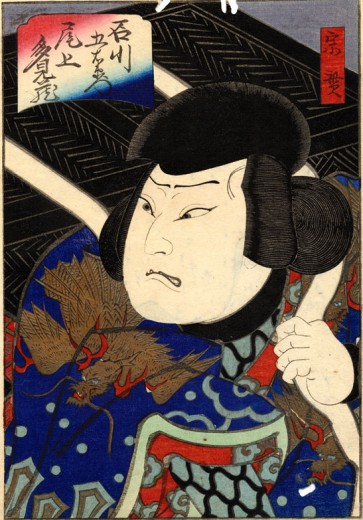Onoe Tamizo II
December 8 (Tue), 2015 – March. 6 (Sun), 2016
This museum mainly exhibits Ukiyo-e prints and paintings produced in Osaka from the latter half of the Edo period to the beginning of Meiji period. Most Ukiyo-e paintings made in Osaka were of portraits of actors playing kabuki in theatres.
In Osaka kabuki plays were played not only in large theatres like Naka-za and Kado-za in Dotombori area, but also played on the premises of a shrine, which is called miyachi shibai. Some actors at these miyachi shibai were able to seize the opportunity to succeed by his popularity and performance skills.
In this feature exhibition we focus on Onoe Tamizo II. Tamizo started his career in miyachi shibai and child thatres and was discovered his talent by Nakamura Utaemon III and Onoe Kikugoro III. Then he became one of the greatest Kabuki actors of all time. See in ukiyo-e paintings how he grew into a man of great presence.
 Onoe Tamizo II as Ishikawa Goemon drawn by Soko
Onoe Tamizo II as Ishikawa Goemon drawn by Soko
Onoe Tamzo II
Born in Kyoto in Kansei 12 (1800), as the son of Kameemon, a kabuki hairdresser. In the middle of Bunka era (1804-1817), he was popular as a child actor by the name of Segawa Waichi. Later he became a disciple of Nakamura Utaemon III and changed his surname to Nakamura.
In Bunsei 3 (1820), he became a disciple of Onoe Kikugoro III and took the name of Onoe Tamizo II when he performed Kabuki play in Edo.
In Bunsei 6 (1823), he went back to Osaka and became popular in nakashibai (small thatres) including Takeda and Onishi. He gradually got highly regarded as an actor, playing together in a big theatre with Nakamura Utaemon. In Tempo 12 (1841) and Koka 3 (1846), he again went to Edo and played in theatres including Namamura-za, becoming a prominent figure in both east and west.
Tamizo continued playing Kabuki in the Meiji Period, and performance on the stage at Naka-za theatre in Meiji 18 (1885) was his last and he retired on March 2, Meiji 19, after his long life as an actor.
Nakamura Utaemon III and Onoe Kikugoro III
Nakamura Utaemon III achieved the greatest success among actors in Osaka Kabuki world in the latter half of the Edo period. He was very popular and were often drawn in Ukiyo-e. Though he wasn’t very good-looking, he was called “kaneru yakusha, which means “an actor who performs a wide variety of roles”, by his excellent acting ability.
Onoe Kikugoro III was an Kabuki actor who represented the Edo Kabuki world and often performed in thatres in Osaka. It is said that Tamizo became Kikugoro’s disciple because they performed in the same theatre in Sakai. Kikugoro was also called “kaneru yakusha” as he performed a wide variety of roles, men and women.
Tamizo was also called “kaneru yakusha” after he performed a wide variety of roles. Meeting with Utaemon and Kikugoro is said to have large impact on Tamizo’s performance.
Appearance drawn in Ukiyo-e
It is said that Osaka Ukiyo-e portraits of actors’ are easier to distinguish actors’ faces than those of Edo Ukiyo-e portraits.
Tamizo from Bunsei era to Tempo era (around 1820-1840) was portrayed as a good-looking man with almond eyes and graceful face. Uncovered legs were in good shape, implicating his light motion.
But as he got older, he became portrayed clearly as heavier man with his cheeks and body plumper.
Please pay attention to Tamizo’s changes in appearances who lived and was portrayed as an actor for a long time.
Tamizo II’s disciples
Tamizo II married to Ichikawa Ebijuro’s daughter and had three sons and a daughter. The eldest son, Onoe Waichi II (his other stage names included Shokaku and Shoko), and the second son, Ichikawa Ichizo III, became actors but both died young. After Tamizo II’s death, a disciple succeeded the name as Tamizo III, but there is no successor after that.
Tamizo II inherited the skill of performing the role in ghost plays and the art of quick change of costume and was good at them. These skills were inherited by Ichikawa Udanji and others.
Onoe Shoroku (not acknowledged as an official member of the line) is also a disciple of Onoe Tamizo II. You can see his figure in Ukiyo-e prints.